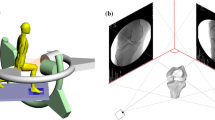Abstract
The inaccuracy of full extension measurements can lead to errors, especially in reconstructive surgery of the knee and in the rehabilitation period following total knee replacement. The goal of this study was to first determine whether plain lateral X-rays of the knee can be used to measure the axis of the bones of the lower limb. The second goal was to determine whether the angle from which the X-ray is taken influences the true angle of the knee. We analyzed 620 digital photographs of cadaver knees to measure the difference between the true axis of the femur and tibia compared with lines drawn on the anterior and posterior cortex of the femur and tibia. We also analyzed 150 photographs of cadaver lower limbs to determine how the true flexion angle compares to the angles measured if the picture was taken from different rotated positions (maximum of 30°). Our results concluded that lines drawn onto the distal anterior cortex of the femur and proximal posterior cortex of the tibia can determine the true flexion angle with 2° of accuracy. We also concluded that lateral X-rays of the knee taken within ±30° of the true lateral position only causes a maximum of a 2% discrepancy in the true flexion angle.







Similar content being viewed by others
References
Lavernia C, D’Apuzzo M, Rossi MD, Lee D (2008) Accuracy of knee range of motion assessment after total knee arthroplasty. J Arthroplasty 23(6 Suppl 1):85–91
Austin MS, Ghanem E, Joshi A, Trappler R, Parvizi J, Hozack WJ (2008) The assessment of intraoperative prosthetic knee range of motion using two methods. J Arthroplasty 23(4):515–521
Boone DC, Azen SP, Lin CM, Spence C, Baron C, Lee L (1978) Reliability of goniometric measurements. Phys Ther 58(11):1355–1360
Jagodzinski M, Kleemann V, Angele P, Schonhaar V, Iselborn KW, Mall G, Nerlich M (2000) Experimental and clinical assessment of the accuracy of knee extension measurement techniques. Knee Surg Sports Traumatol Arthrosc 8(6):329–336
Hoppenfeld S (2009) Clinical examination of the knee joint. In: Physical examination of the spine and extremities. Prentice Hall, London, pp 181–206
Martin-Hernandez C G-SM, Castro-Sauras A, Ballester-Jimenez JJ, Espallargas-Doñate T, Fuertes-Vallcorba A (2009) Comparison of high-flex and conventional implants for bilateral total knee arthroplasty. Internet J Orthop Surg 14(1)
Williams M, Lissner HR (1962) Useful terms and concepts. In: Biomechanics of human motion. Saunders, Philadelphia, pp 12–13
Unver B, Karatosun V, Bakirhan S (2009) Reliability of goniometric measurements of flexion in total knee arthroplasty patients: with special reference to the body position. J Phys Ther Sci 21(3):257–262
Cleffken B, van Breukelen G, Brink P, van Mameren H, Olde Damink S (2007) Digital goniometric measurement of knee joint motion. Evaluation of usefulness for research settings and clinical practice. Knee 14(5):385–389
Rachkidi R, Ghanem I, Kalouche I, El Hage S, Dagher F, Kharrat K (2009) Is visual estimation of passive range of motion in the pediatric lower limb valid and reliable? BMC Musculoskelet Dis 10:126
Bull AMJ, Amis AA (1998) Knee joint motion: description and measurement. Proc Inst Mech Eng H 212(H5):357–372
Jordan K, Dziedzic K, Mullis R, Dawes PT, Jones PW (2001) The development of three-dimensional range of motion measurement systems for clinical practice. Rheumatology 40(10):1081–1084
McGill SM, Cholewicki J, Peach JP (1997) Methodological considerations for using inductive sensors (3space isotrak) to monitor 3-d orthopaedic joint motion. Clin Biomech (Bristol, Avon) 12(3):190–194
Dubousset J, Charpak G, Skalli W, de Guise J, Kalifa G, Wicart P (2008) Skeletal and spinal imaging with eos system. Arch Pediatr 15(5):665–666
Bennett D, Hanratty B, Thompson N, Beverland D (2009) Measurement of knee joint motion using digital imaging. Int Orthop 33(6):1627–1631
Edwards JZ, Greene KA, Davis RS, Kovacik MW, Noe DA, Askew MJ (2004) Measuring flexion in knee arthroplasty patients. J Arthroplasty 19(3):369–372
Conflict of interest
No funds were received in support of this study.
Author information
Authors and Affiliations
Corresponding author
Rights and permissions
About this article
Cite this article
Manó, S., Pálinkás, J., Kiss, L. et al. The influence of lateral knee X-ray positioning on the accuracy of full extension level measurements: an in vitro study. Eur J Orthop Surg Traumatol 22, 245–250 (2012). https://doi.org/10.1007/s00590-011-0808-8
Received:
Accepted:
Published:
Issue Date:
DOI: https://doi.org/10.1007/s00590-011-0808-8




